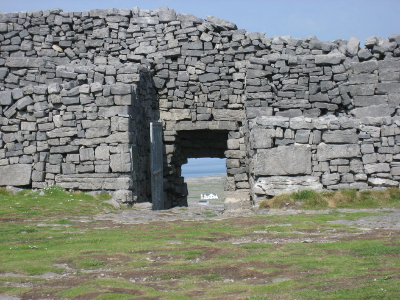Dún Aonghasa (anglicized as Dun Aengus) is a prehistoric stone fort located on the island of Inishmore, one of the Aran Islands in County Galway, Ireland. It was built at least 3,000 years ago. Precariously perched at the edge of a 300-foot high cliff (100 meters), it is surrounded by three concentric walls that begin and end at the cliff edge, as well as a partial fourth wall. While the fort may originally have been oval, it is now horseshoe-shaped; part of the structure was lost when a section of the cliff fell into the sea. Today, the site covers an area of about 14 acres.
The massive, dry-stone walls are up to 13 feet thick (about four meters) and 18 feet high (five and one half meters), and have built-in doorways, stairs, and chambers. The innermost wall encloses an area now referred to as the “citadel,” which likely protected a royal court.
 A “chevaux-de-frise,” or obstacle course of vertically-placed boulders, also defends the fort. The 50-70 foot long (15-21 meter) boulder field includes stones that have been shaped into spikes. It is one of only four surviving Irish sites with this feature.
A “chevaux-de-frise,” or obstacle course of vertically-placed boulders, also defends the fort. The 50-70 foot long (15-21 meter) boulder field includes stones that have been shaped into spikes. It is one of only four surviving Irish sites with this feature.
The fort appears to have been built around a naturally-occurring, nearly square rock outcrop that could have served as a platform for several buildings. While traces of stone huts have been found at similar duns, none have been discovered at Dún Aonghasa. It is possible that huts made of wood or mud may have once existed there, and have since decomposed.
Dún Aonghasa would have made an excellent fortress; the people there could have seen vast stretches of coastline from that vantage point, and were protected from ships approaching from the sea. However, some scholars believe it could have served as a ceremonial center, or even a defended settlement. The various enclosures may have housed different classes of a tribe, as well as their livestock.
According to Irish legend, Dún Aonghasa was named for Oengus, chief of the Fir Bolg people. His father, Umor, reportedly built and settled the fort around the time of Christ. However, scholars believe the structure to be far older. Oengus may simply have been the first permanent occupant who was known by name to later generations.
While the walls were partially reconstructed in the 1880s, no excavation has ever been carried out there, and the site has not been precisely dated.
Today, Dún Aonghasa is one of the most popular tourist attractions in the Aran Islands.
Photo credit:
Kathryn Rotondo/flickr/CC BY 2.0